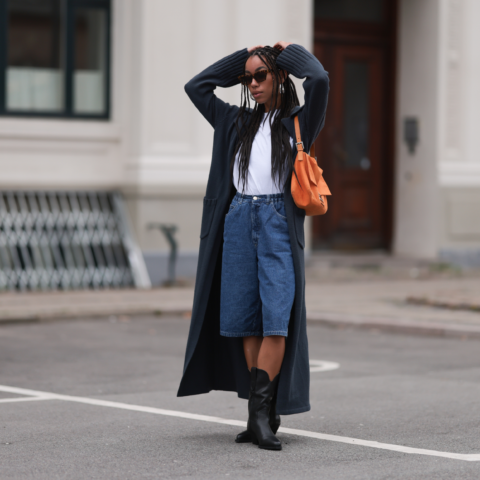Designer clothes at discount prices: We explore the new wave of online retail with a tour of The Outnet headquarters in London


Online-shopping veteran Rebecca Tay explores the digital world of discount ready-to-wear while taking an exclusive tour of The Outnet’s HQ in London.
See the global top sellers | See the Canadian top sellers
Online-shopping virgins are rare these days. Any girl worth her weight in Wang (whether it’s Alexander or Vera) has not only done the deed but also experimented with the latest spine-tingling activity: trolling the web for designer discounts. Who hasn’t hit the sheets with their laptop primed for a little ready-to-wear rollback action? Half-price Lanvin ballet flats? Yes, please! Erdem floral dresses for a fraction of their original price? Click: “buy!” E-boutiques like Shopbop, Asos and Net-A-Porter have huge followings, but the new stars of the online retail world are the luxury-good bargain hunters. When it comes to these price-choppy waters, The Outnet is the mother ship, drawing more than one million unique visitors every month. It was launched in 2009 as an offshoot of Net-A-Porter, which was one of the first companies to offer designer brands online. With more than 200 high-end labels to browse, including Stella McCartney, Marni, Balmain and Marc Jacobs, this site is a destination for marked-down must-haves. Boots that once cost a month’s rent are now $200; almost everything, from Alexander McQueen to Zac Posen, is 50 to 70 per cent off. It’s a virtual dream, but I get the chance to see if this fairy-tale land of luxe-for-less really exists beyond the screen when I receive an exclusive invitation to spend a day at The Outnet.
It feels like fate that in a city where hour-long commutes are the norm, the company’s head office is only 25 minutes from my flat, at the Westfield shopping complex in west London. The first hint that I’m heading into fashion mecca is a trio of model-tall girls with long, swingy hair—one is wearing the Isabel Marant fringed boots I coveted last fall—on the escalator in The Village, an area dedicated to high-end stores like Miu Miu, Burberry, Jimmy Choo and Mulberry. The cherry on top of this decadent designer sundae is The Outnet’s office, which spans The Village’s entire upper level. It turns out that this gang of glamazons are three of the Net-A-Porter group’s 1,800 employees. I follow them into an expansive, ultra-modern office where graphic black and white reigns supreme and ceilings are higher than 30 feet. Clearly, this is where high-tech meets high fashion: There are futuristic, leather-panelled meeting pods and three photography studios with soundproof walls (ideal for blasting Kanye West and The Kills). The biggest Jo Malone candles I’ve ever seen—nearly a foot in diameter—flicker in the main foyer. A large, wall-mounted flat-screen monitor runs a ticker tape of daily sales (by 11 a.m. it’s already flashing five-figure numbers) and other pertinent information like who’s shopping (mostly women), what they’re buying (an Yves Saint Laurent ring here, a Tory Burch tunic there) and where they live (Europe, Asia and Africa; North Americans are still sleeping). During the site’s most recent clearance sale, in November 2011, the screen captured a record 29 purchases per second.
These figures are the domain of The Outnet’s managing director, Stephanie Phair. Despite being eight months pregnant and one week shy of her maternity leave, she radiates chic in a grey Calvin Klein sweater dress, black opaque tights and Belle by Sigerson Morrison lace-up wedge boots when she greets me at the door to her office. Her sweet demeanour is more princess than powerhouse, but I don’t let that fool me. Before joining The Outnet, this 33-year-old Oxford-educated Brit (she speaks four languages fluently, including French, Spanish and Italian) worked at U.S. Vogue in PR and marketing, and at Portero, an online-auction company, as VP of merchandising. In addition to devising The Outnet’s strategy and direction, she manages relationships with the 200 to 250 brands sold on the site. One of those is Christian Louboutin, a top seller. In 2010, when the site unveiled a large delivery of the coveted red-soled shoes, one pair sold every three seconds. How do they keep up with this demand?
Not with much help from Net-A-Porter, it turns out. Only 30 per cent of The Outnet’s merchandise comes from its big-sister site; the majority is purchased directly from the brands. “Buying at discount is a different discipline than buying at full price,” says Phair. “At full price, it’s all about going into a showroom and selecting. The nature of discounted product is that you have to work with what’s there, and edit it.” What’s more, the buy is often blind. “Brands collect inventory and don’t always know what they have left,” she explains. “We’ll buy it all, in big lots, and get the best deal.”
This is why the edit—the process of making the merchandise appealing to the customer—is key. It’s the difference between searching a rack of dresses for a Jil Sander shift to wear to an upcoming cocktail party and being shown to a fitting room where this exact dress and all the right accoutrements—bag, heels, statement earrings—have been selected and displayed for you. This sort of personal-shopper service is what The Outnet’s weekly Dress Me feature is all about. Merchandise is sorted by occasion and trend: Have a big date? Browse pre-styled looks ranging from a Helmut Lang mini-dress with strappy Alaïa heels to a Matthew Williamson leather bomber jacket and J Brand skinny jeans. Similar to a print magazine, these editorial spreads cover everything from work to weekend wear to special event and vacation essentials, reinforcing the site’s Buy Now, Wear Now philosophy. Online videos starring popular bloggers and industry insiders such as Style.com executive editor Nicole Phelps give shoppers styling tips and help them visualize how an item will work with their existing wardrobe. The transition from computer screen to closet is seamless, designed to drive customers to buy.
En route to one of the in-house photography studios, Phair and I stop outside Natalie Massenet’s office. My heart starts pounding. In the online fashion retail world, she is queen. And suddenly she is in front of me, wearing a crisp black cotton shirt and slim black trousers. She is petite, though anything but diminutive. She founded Net-A-Porter in 2000, and reportedly banked £50 million 10 years later, when she sold her share to Richemont luxury group. She remains the chairman. When I inquire about her plans to expand the airport-sized space, she cracks a smile. “I’ve asked them not to move my office again,” she says, “or I won’t be able to walk there in heels.”
Outside the photo studio it’s calm and quiet, but inside it’s buzzing with activity: A DJ mix blares over the sound system as a twentysomething editor, sporting a loose cardigan and a topknot, reviews product shots on a computer. A stylist preps a spotlit mannequin dressed in a black frock. I spot an Alexander Wang shoebox and a Pamela Love spiked cuff on a shelf next to the racks of garment bags. The merchandise being shot today will go live in less than a month; new products are uploaded every Monday, Tuesday and Thursday. When I stop to consider the global net the site casts (170 countries and counting) and the sheer volume of product this must entail—none of it in evidence during my tour—I wonder where all of these haute goodies are stored.
The answer to this is a fully automated distribution and order fulfillment centre in southeast London that opened last fall, complete with robots that pick and pack orders for shipment around the world. The robots keep things moving at a good clip and allow merchandise to be stored at otherwise dangerous heights. Every new staff member is brought in to see this facility; I ask if I can see it too. “I don’t think that will be possible,” says Phair with a polite smile. (Several weeks after my visit, I try again via email. This time, the PR manager offers a more official response: “The distribution centre is off limits to people outside the company because of the security required to keep the merchandise safe and secure from loss.”) Sigh. At 168,000 square feet—roughly three football fields—this mega-space houses the company’s inventory for Africa, Asia, Europe, Oceania and the Middle East. North and Latin America are served by a similar facility in New Jersey, set to become fully automated this year, and a third location in China is scheduled to open soon. “We want to be a global destination,” says Phair.
These aren’t the only signs of expansion. This year, The Outnet plans to further develop its StyleCred iPhone app, to allow users to create looks, share them with friends and shop on the go. It will also expand its offerings on other mobile platforms such as Android. Facebook commerce is being evaluated, to answer the question: Are The Outnet’s 200,000-plus “fans” shopping on the site or simply writing on its Wall?
Later in the evening, after my tour, I hop into bed with my iPad, eager to surf the site with my new insider’s perspective. Almost immediately, I forget about the company’s inner workings and am instead drawn to the deals: Marni sunglasses for $100, Theyskens’ Theory tees at Gap prices. I add everything to my virtual shopping bag and click “buy.” Any girl will tell you, it’s a mind-blowing experience.







